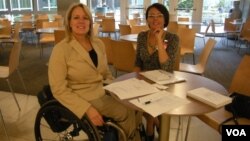Ann E. Cody lives in a wheelchair. Until she was 16, Ann had a normal life and plenty of ambitions. But then, suddenly, her body was attacked by a virus. Since then she has been a paraplegic, unable to move the lower half of her body. She has lived in a wheelchair for 35 years.
“At that time, I had wishes, and wanted to go to college. Before becoming disabled, I didn’t think about people with disabilities, about accessibility to public buildings for those people,” she said. But after her life changed, she discovered that very little was accessible for people with disabilities.
“The United States had the Rehabilitation Act of 1973, but it (the law) didn’t work in all areas,” she said.
The Rehabilitation Act barred discrimination because of disability in programs conducted by federal agencies, in programs receiving federal financial assistance, in federal employment, and in the employment practices of federal contractors. Because the law wasn’t enforced in all areas, it was replaced in 1990 with the Americans with Disabilities Act (ADA).
According to the U.S. Census Bureau, nearly one in five people nationwide have some kind of disability.
“Life for all of us is much easier from that period,” said Cody.
Because of U.S. law, people with disabilities have equal rights with other Americans when seeking employment. The ADA requires employers with 15 or more workers to provide ‘reasonable accommodation’ for individuals with disabilities, unless doing so would cause undue hardship.
The Department of Justice defines reasonable accommodation as any change “to a job or in the work environment that enables a person with a disability to participate in the application process or perform essential job functions.”
The ADA is a wide-ranging civil rights law. It provides legal protections like those in the Civil Rights Act of 1964, which made discrimination based on race, religion, sex, national origin, and other characteristics illegal. Unlike the Civil Rights Act, the ADA requires covered employers to provide reasonable accommodation to employees with disabilities, and imposes accessibility requirements on public accommodations.
Today Cody is a successful woman and lives a normal life. She works for the U.S. Department of State as a program officer in the Bureau of Educational and Cultural Affairs. She has been at the forefront of the U.S. Paralympic Movement for more than 30 years , and served for various international Olympic Committee commissions, international Sport Federation executive committee and Games organizing and bid committees. She has an outstanding record as an athlete and executive in the corporate and sport sectors. But when she wanted to go to college, there was small number of Colleges in the States accessible for people with disabilities.
“In that period, I have to advocate me,” she said. “There were not many accessible universities for people like me. I found out about the University of Illinois, and went there. I visited the campus and it was fully accessible. After my college education, I was on my way to become someone, even if I’m in a wheelchair.
"That was a really happy story for me. I think that for all of us today the biggest problem is the so-called ‘invisibility of that people.’ That’s also the biggest challenge for all. We have to be aware that people with disabilities really exist and they have rights to educate themselves. The Individuals with Disabilities Education Act gave them those rights and requires public school systems to develop appropriate Individualized Education Programs for each child.“
Organizations like the American Association of People with Disabilities (AAPD) have campaigns for promoting the idea that people with disabilities “can and do make important contributions to America’s businesses every day.”
This year the Campaign for Disability Employment is focusing on young people with disabilities and how mentors can help them reach their goals. The AAPD-organized Disability Mentoring Day (DMD) takes place on the third Wednesday of each October during National Disability Employment Awareness Month. This one-day event is part of a nationwide effort to support career development for students and job-seekers with disabilities.
As Ann Cody says, “It’s not enough for people with disabilities to give them rights by the law. Making them visible is much more.”







